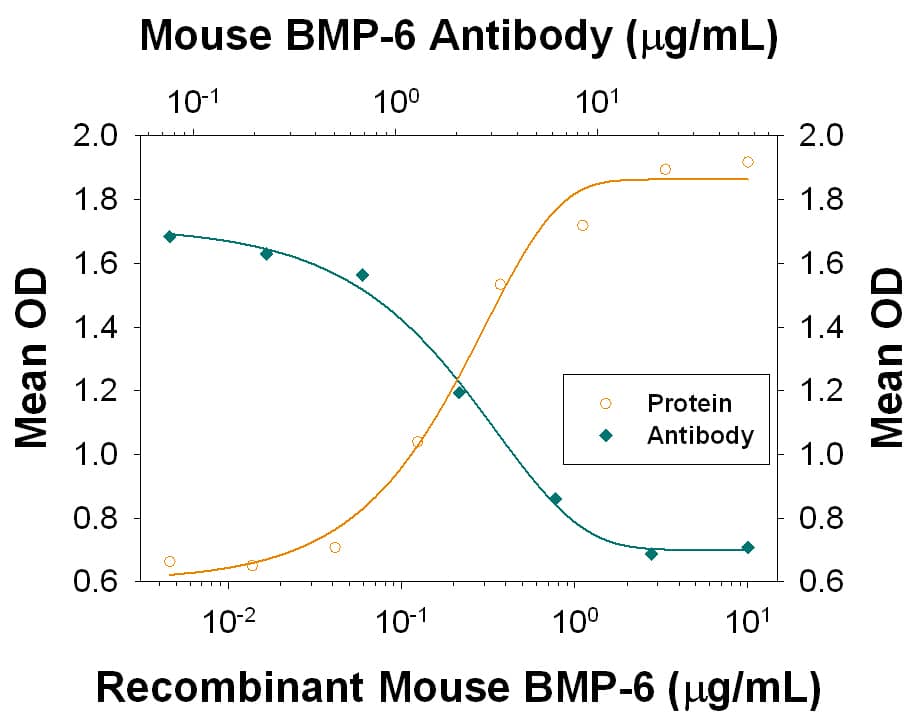Mouse BMP-6 Antibody
R&D Systems, part of Bio-Techne | Catalog # MAB6325

Key Product Details
Species Reactivity
Validated:
Mouse
Cited:
Mouse
Applications
Validated:
Neutralization
Cited:
Neutralization
Label
Unconjugated
Antibody Source
Monoclonal Rat IgG2B Clone # 719040
Product Specifications
Immunogen
Chinese hamster ovary cell line CHO-derived recombinant mouse BMP-6
Met1-His510
Accession # P20722
Met1-His510
Accession # P20722
Specificity
Detects mouse BMP-6 in ELISAs.
Clonality
Monoclonal
Host
Rat
Isotype
IgG2B
Endotoxin Level
<0.10 EU per 1 μg of the antibody by the LAL method.
Scientific Data Images for Mouse BMP-6 Antibody
Alkaline Phosphatase Production Induced by BMP-6 and Neutralization by Mouse BMP-6 Antibody.
Recombinant Mouse BMP-6 (Catalog # 6325-BM) induces alkaline phosphatase production in the ATDC5 mouse chondrogenic cell line in a dose-dependent manner (orange line). Alkaline Phosphatase Production elicited by Recombinant Mouse BMP-6 (0.5 µg/mL) is neutralized (green line) by increasing concentrations of Rat Anti-Mouse BMP-6 Monoclonal Antibody (Catalog # MAB6325). The ND50 is typically 1.5-7.5 µg/mL.Applications for Mouse BMP-6 Antibody
Application
Recommended Usage
Neutralization
Measured by its ability to neutralize BMP‑6-induced alkaline phosphatase production in the ATDC5 mouse chondrogenic cell line. Asahina, I. et al. (1996) Exp. Cell Res. 222:38. The Neutralization Dose (ND50) is typically 1.5-7.5 μg/mL in the presence of 0.5 μg/mL Recombinant Mouse BMP‑6.
Formulation, Preparation, and Storage
Purification
Protein A or G purified from hybridoma culture supernatant
Reconstitution
Reconstitute at 0.5 mg/mL in sterile PBS. For liquid material, refer to CoA for concentration.
Formulation
Lyophilized from a 0.2 μm filtered solution in PBS with Trehalose. *Small pack size (SP) is supplied either lyophilized or as a 0.2 µm filtered solution in PBS.
Shipping
Lyophilized product is shipped at ambient temperature. Liquid small pack size (-SP) is shipped with polar packs. Upon receipt, store immediately at the temperature recommended below.
Stability & Storage
Use a manual defrost freezer and avoid repeated freeze-thaw cycles.
- 12 months from date of receipt, -20 to -70 °C as supplied.
- 1 month, 2 to 8 °C under sterile conditions after reconstitution.
- 6 months, -20 to -70 °C under sterile conditions after reconstitution.
Background: BMP-6
References
- Chen, D. et al. (2004) Growth Factors 22:233.
- Lyons, K. et al. (1989) Proc. Natl. Acad. Sci. 86:4554.
- Inagaki, K. et al. (2006) Endocrinology 147:2681.
- Hong, J.H. et al. (2008) Immunology 128:e442.
- Lavery, K. et al. (2008) J. Biol. Chem. 283:20948.
- Saremba, S. et al. (2008) FEBS J. 275:172.
- Haudenschild, D.R. et al. (2004) Cancer Res. 64:8276.
- Kersten, C. et al. (2005) BMC Immunol. 6:9.
- Grimsrud, C.D. et al. (1999) J. Bone Miner. Res. 14:475.
- Shi, J. et al. (2009) Fertil. Steril. 92:1794.
- Yabe, T. et al. (2002) J. Neurosci. Res. 68:161.
- Zhang, Z. et al. (2006) Neuroscience 138:47.
- Dai, J. et al. (2005) Cancer Res. 65:8274.
- Meynard, D. et al. (2009) Nat. Genet. 41:478.
- Andriopoulos, B. Jr. et al. (2009) Nat. Genet. 41:482.
Long Name
Bone Morphogenetic Protein 6
Alternate Names
BMP6, Vgr-1
Gene Symbol
BMP6
UniProt
Additional BMP-6 Products
Product Documents for Mouse BMP-6 Antibody
Product Specific Notices for Mouse BMP-6 Antibody
For research use only
